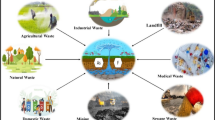Abstract
Phosphorus is one of the controlling factors for water eutrophication, but it is also an essential nutrient for all living organisms and non-renewable resource. A feasibility study on PO43− recovery and conversion to struvite (NH4MgPO4·6H2O), a slow-release fertilizer, has been reported. However, the fertilizer efficiency of struvite is determined by its purity, which depends on the forms and molar ratio of reactants under different initial pH of the solution. Laboratory-scale experiments were carried out to determine the optimum initial pH of the solution and molar ratio of reactants on struvite crystallization. Meanwhile, the purity of the synthesis product struvite was analyzed. The experiment results revealed the optimum initial pH being 10 with molar ratio of PO43−:Mg2+:NH4+= 1:1.3:1 and 1:2:5 for struvite formation, which the removal of the PO43−, Mg2+ and NH4+ being 98, 92, 95% and 99.5, 85, 90%, respectively. A chemical equilibrium model (Visual Minteq) corroborated the experimental results. Thus, the possibility of synthesizing struvite from simulated wastewater utilizing the phosphate ions (PO43−) was confirmed.
Graphical abstract






Similar content being viewed by others
References
Bi W, Li Y, Hu Y (2014) Recovery of phosphorus and nitrogen from alkaline hydrolysis supernatant of excess sludge by magnesium ammonium phosphate. Bioresour Technol 166:1–8
Doyle J, Parsons S (2002) Struvite formation, control and recovery. Water Res 36:3925–3940
Greenlee L, Lawler D, Freeman B, Marrot B, Moulin P (2009) Reverse osmosis desalination: water sources, technology, and today’s challenge. Water Res 43:2317–2348
Hilt K, Harrison J, Bowers K, Stevens R, Bary A (2016) Agronomic response of crops fertilized with struvite derived from dairy manure. Water Air Soil Pollut 227(10):388
Husein D, Al-Radadi T, Danish E (2017) Adsorption of phosphate using alginate-/zirconium-grafted newspaper pellets: fixed-bed column study and application. Arab J Sci Eng 42(4):1–14
Iqbal M, Murtaza G, Naz T, Akhtar J, Afzal M (2017) Amendments affect lead mobility and modulated chemo-speciation under different moisture regimes in normal and salt-affected lead-contaminated soils. Int J Environ Sci Technol 14(1):1–10
Li X, Barnes D, Chen J (2011) Performance of struvite precipitation during pretreatment of raw landfill leachate and its biological validation. Environ Chem Lett 9(1):71–75
Martín M, Gargallo S, Hernández-Crespo C, Oliver N (2013) Phosphorus and nitrogen removal from tertiary treated urban wastewaters by a vertical flow constructed wetland. Ecol Eng 61:34–42
Nur T, Johir M, Loganathan P, Vigneswaran S, Kandasamy J (2014) Phosphate removal from water using an iron oxide impregnated strong base anion exchange resin. J Ind Eng Chem 20:1301–1307
Park S, Yoo J, Ji S, Yang J, Baek K (2015) Selective recovery of dissolved Fe, Al, Cu, and Zn in acid mine drainage based on modeling to predict precipitation pH. Environ Sci Pollut Res 22(4):1–10
Prabhu M, Mutnuri S (2014) Cow urine as a potential source for struvite production. Int J Recycl Org Waste Agric 3(1):49–60
Seminskaya O, Balakina M, Kucheruk D (2017) Processing of retentates of reverse osmosis treatment of phosphate-containing wastewater. J Water Chem Technol 39(3):171–176
Siciliano A (2016) Assessment of fertilizer potential of the struvite produced from the treatment of methanogenic landfill leachate using low-cost reagents. Environ Sci Pollut Res 23(6):5949–5959
Song X, Pan Y, Wu Q, Cheng Z, Ma W (2011) Phosphate removal from aqueous solutions by adsorption using ferric sludge. Desalination 280:384–390
Talboys P, James H, Tiina R, Healey J, Jones D (2016) Struvite: a slow-release fertiliser for sustainable phosphorus management? Plant Soil 401(1–2):109–123
Uysal A, Demir S, Sayilgan E, Eraslan F, Kucukyumuk Z (2014) Optimization of struvite fertilizer formation from baker’s yeast wastewater: growth and nutrition of maize and tomato plants. Environ Sci Pollut Res 21(5):3264–3274
Wang J, Song Y, Yuan P, Peng J, Fan M (2006) Modeling the crystallization of magnesium ammonium phosphate for phosphorus recovery. Chemosphere 66(7):1182–1187.
Wei Y, Lu J, Dong X, Hao J, Yao C (2017) Coagulation performance of a novel poly-ferric-acetate (PFC) coagulant in phosphate–kaolin synthetic water treatment. Korean J Chem Eng 34(10):2641–2647
Woumfo E, Siewe J, Nijopwouo D (2015) A fixed-bed column for phosphate removal from aqueous solutions using an andosol-bagasse mixture. J Environ Manag 151:450–460
Wu Y, Zhou S (2012) Improving the prediction of ammonium nitrogen removal through struvite precipitation. Environ Sci Pollut Res 19:347–360
Yang Y, Cui K, Sun S, Kong D, Shi F (2011) Characterization of magnesium ammonium phosphate precipitation with different pH values. J Hefei Univ Technol 34(6):910–915
Yu R, Ren H, Wu J, Zhang X (2017) A novel treatment processes of struvite with pretreated magnesite as a source of low-cost magnesium. Environ Sci Pollut Res 24(28):22204–22213
Zhang J, Chen S, Wang X (2015) Sustainable treatment of antibiotic wastewater using combined process of microelectrolysis and struvite crystallization. Water Air Soil Pollut 226(9):1–11
Zhou Y, Lisowski W, Zhou Y, Jern N, Huang K (2017) Genetic improvement of Magnetospirillum gryphiswaldense for enhanced biological removal of phosphate. Biotechnol Lett 39(10):1509–1514
Acknowledgements
This work was supported the National Natural Science Foundation of China (No. 51568023). Additionally, the authors would like to express their sincere appreciation to the anonymous reviewers for their helpful comments and suggestions.
Author information
Authors and Affiliations
Contributions
YC presented the original idea for the study, carried out the experiment, analyzed the data and drafted the manuscript. CL, LG and CL have participated in the supplementary experiment. JN modified the manuscript. All authors have read the manuscript and agreed to submission.
Corresponding author
Rights and permissions
About this article
Cite this article
Chen, Y., Liu, C., Guo, L. et al. Removal and recovery of phosphate anion as struvite from wastewater. Clean Techn Environ Policy 20, 2375–2380 (2018). https://doi.org/10.1007/s10098-018-1607-2
Received:
Accepted:
Published:
Issue Date:
DOI: https://doi.org/10.1007/s10098-018-1607-2




